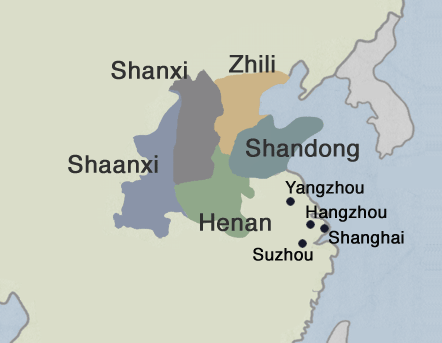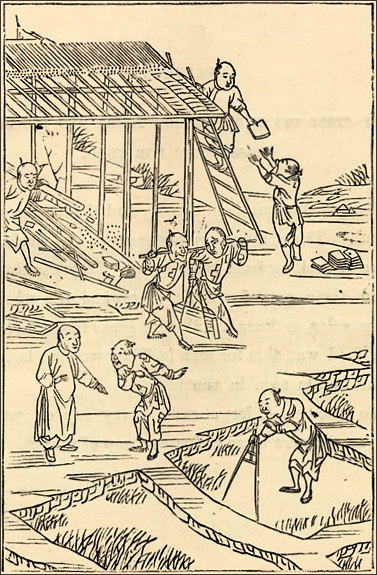| |
The Famine in China, 1878
|
|
| |
Between 1876 and 1879, the most lethal drought-famine in imperial China’s long history of famines and disasters struck the five northern provinces of Shanxi, Henan, Shandong, Zhili, and Shaanxi. The drought in the Yellow River basin area began in earnest in 1876, and worsened dramatically with the almost total failure of rain in 1877. By the time the rains returned late in 1878, an estimated nine to thirteen million of the affected area’s total population of about 108 million people had perished. [1]
This unit examines famine illustrations from a collection of pamphlets
produced by Chinese philanthropists with the purely
domestic objective of soliciting contributions to help relieve this
enormous disaster. In 1878, a London-based committee of
missionaries, diplomats, merchants, and scholars established a China
Famine Relief Fund to broaden the relief effort. To help bring the
horror of the famine home to their Western audience, the committee
enlisted the great sinologist James Legge (1815-1897) to translate one
of the illustrated pamphlets. His title—taken from the
original Chinese—was “Pictures Illustrating the Terrible Famine in
Honan that Might Draw Tears from Iron.”
This unit reproduces Legge’s
translation in full, including the original plates (with bracketed notations beginning in “Legge”). It also draws illustrations from additional
pamphlets that were never translated into English. The social and cultural dynamics of the Chinese
response to the famine are addressed in the
essay that follows.
|
|
| |
INTRODUCTION
The North China Famine had local, national, and global implications. [2] It forced a series of hideous moral choices upon starving families in Shanxi Province, where the famine was most severe. Striking only a decade after the Qing government (1644 to 1911) finally suppressed three mid-century rebellions that had threatened to topple the dynasty, the famine also presented a serious crisis for an empire already beleaguered by foreign aggression, internal unrest, and fiscal woes.
|
|
| |

Provinces affected by the famine of 1876–1879
|
|
| |
The severity and scope of the disaster galvanized into action not only the Qing court and the officials in charge of relieving the famished northern provinces, but also Chinese and Western philanthropists living in the treaty port of Shanghai. The catastrophe received widespread coverage in Chinese and English-language newspapers published in Shanghai. As the most lethal of the drought-famines that also affected India, Brazil, Korea, Egypt, and southern Africa in the late 1870s, the disaster drew attention as well from newspapers and missionary journals in Europe and North America. [3]
As the famine grew ever more severe during the spring of 1878, Chinese philanthropists from the Taohuawu Public Hall in Suzhou, a city in China’s wealthy Jiangnan (lower Yangzi) region, designed and printed a small pamphlet titled The Incredible Famine in Henan: Pictures to Draw Tears from Iron (Henan qihuang tieleitu). The twelve woodblock print illustrations of famine conditions in Henan Province, each accompanied by an eight-character heading and a poetic lament, sought to rouse people to contribute to relief efforts by making even “people of iron” (tieren) shed tears upon viewing them. [4]
The text next to the first illustration in the “tears from iron” pamphlet, for example, described how famine victims were forced to kill their plough oxen, pawn their farming tools and their clothing, and finally sell their fields and take their houses to pieces in a desperate effort to survive. The last sentence begged readers to have compassion: “Think of this, you who live in high halls and fine houses, and let your hearts be moved.” [5]
|
|
 |
“They Sell Their Fields and
Take Their Houses to Pieces”
[Legge plate I] |
| |
China’s first modern newspaper, the Shanghai-based Shenbao, introduced the illustrations to its treaty-port readers and praised them as an innovative method of raising famine relief funds. [6] Later in 1878 the booklet of “pictures to draw tears from iron” was translated into English and published in London. British members of the Committee of the China Famine Relief Fund hoped it would “help to carry home to English hearts a sense of the dire distress from which these unhappy people are now suffering, and call forth from benevolent persons in this country also, a practical expression of sympathy.” [7]
Xie Jiafu, who directed the Taohuawu public hall and led the Suzhou relief effort during the disaster, was the person primarily responsible for compiling and distributing the illustrated famine pamphlets. Philanthropists in Shanghai and elsewhere in Jiangnan, however, shared the work of writing the poetic laments that accompany each illustration. [8] Between 1877 and 1881 Xie Jiafu and his colleagues designed five additional pamphlets of disaster illustrations, which were compiled together in a volume titled “Pictures Reporting Disaster in Four Provinces” (Si sheng gao zai tu qi). [9] The illustrations in this unit are drawn from both the original Henan qihuang tieleitu and from the larger collection of disaster prints that includes famine scenes not only from Henan Province, but from Shandong, Shanxi, and Zhili as well. [10]
|
|
| |

|
|
|





